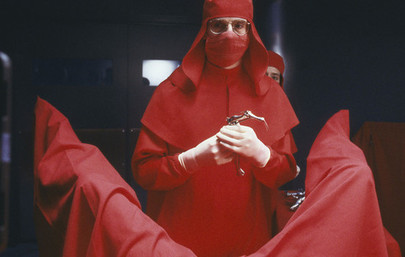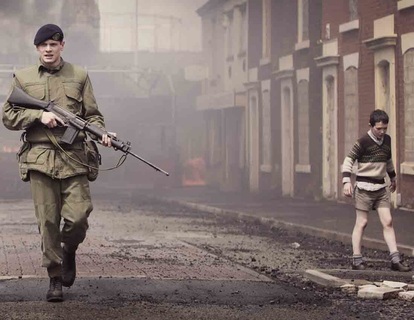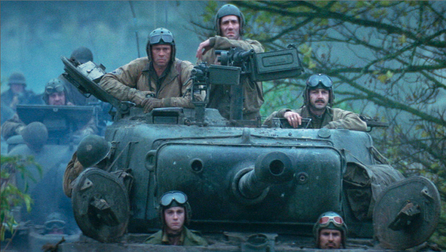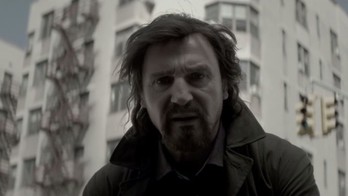
Body horror master David Cronenberg transitions into a more restrained phase of his career with Dead Ringers, despite having the perfect Cronenbergian premise. In Dead Ringers, Jeremy Irons plays both Elliot and Beverly Mantle, a pair of virtuoso gynecologist twins that often impersonate each other in romantic situations. The medical setting is ideal for Cronenberg’s penchant for dissection and transformation, and while there is certainly some of that in Dead Ringers, the emphasis is more on psychological decay, another Cronenberg staple. Though Dead Ringers could’ve showcased some truly nauseating and shocking imagery, its most memorable images are of its once-suave and professional protagonists devolving into shells of their former selves.
The Mantle twins are destined for medicine. Introduced as kids, they play ‘doctor’ not as curious children but with medical books and diagrams and accurate models. During medical school, they devise tools which invite the skepticism of their instructors, who are left to eat crow when the twins are rewarded for their ingenuity by the broad medical community. As adults, they run a successful boutique clinic as renowned experts in their field. Though they share a talent for gynecology and obstetrics, their personalities are drastically different, though complementary. Elliot is the public face of the practice, schmoozing with colleagues and accepting awards, while Beverly is the scholar, poring through journals at their shared home. Outside of work, Elliot’s sexual appetite is so voracious that there’s plenty left over for Beverly. As his brother’s sexual scavenger, Beverly pretends to be Elliot and sleeps with women that Elliot has grown tired of, always at his brother's urging.
This subterfuge is a regular routine for them, with Beverly getting sexual gratification without the time investment that is dating and Elliot gets to feel magnanimous towards his shy brother and spare himself difficult break-ups. Things change when actress Claire Niveau (Genevieve Bujold) enters the fray. First encountering the Mantles during a checkup that reveals a rare anatomical defect, Claire is quickly seduced by Elliot. After Elliot is done with her, Beverly sidles in and gets emotionally attached, complicating the Mantles’ dynamic. Not only is Claire eventually going to find out that they’re twins and blow the charade, but a relationship with a third person disrupts the communitarian norm of two brothers that share everything, while also introducing dishonesty where before there was only truth (at least between the Mantles). Beverly gets something that Elliot can’t have, which drives a wedge, which distances Beverly from his brother, which makes them both unstable.
Irons is masterful in a role that has a high degree of difficulty. Not only is he playing two distinct characters, but those characters also regularly impersonate each other. The role contains layers on top of layers. When things are fine in the early going, Irons ably differentiates the two in bearing and wardrobe. Elliot stands straighter and has a lower neckline on his shirts while Beverly is hunched and buttoned-up and avoids eye contact. In scenes that the two characters share, Irons conveys a lived-in chemistry with himself, immersing the viewer in the Mantles’ close relationship while blinding them to the cinematic trickery. As things start to turn, Irons ably goes for breakdowns both tearful and angry, while also blurring the lines between which Mantle is which. The disruption in their relationship makes Beverly more like Elliot and vice versa, a result that is part head-scratcher and all superb acting.
While Dead Ringers features, for my money, the best performance Cronenberg's ever captured, it also contains some of the more chilling imagery. With one exception, however, the camera doesn’t rub the viewer’s senses in gore and squishes, relying instead on imagination. The surgical scenes in particular are iconic, with the simple choice to clothe the staff and the patient in red scrubs paying off huge dividends. The color, plus the appearance of hoods, give these scenes the feel of a medieval torture chamber and set the viewer on edge for what is about to happen. That pump has already been primed by a montage of antiquated surgical tools and anatomical drawings over the opening credits, so when the film ventures into the operating room, anything can happen. As Beverly’s composure dissolves, he becomes obsessed with gynecological tools that can be used specifically for mutant women, and when those tools, which look like metallic insect appendages, are brought into the red-saturated environment of the operating room, the film is at peak Cronenberg. Where a film like History of Violence shows everything, Dead Ringers is just as effective in its withholding. All Cronenberg has to do is dream up the costuming and the props, and the viewer can do the rest.
Dead Ringers is a serious accomplishment. Cronenberg is trying something moderately different here, and the result is a more polished film. Between the druggy doctors and the mutant women, the temptation to dive into the body horror must have been irresistible, but he sticks with the decision to leave the focus on the characters. While not quite the perfectly calibrated craziness/tragedy of the Fly, Dead Ringers is firmly in the upper echelon of the Canadian auteur’s filmography. B+




 RSS Feed
RSS Feed